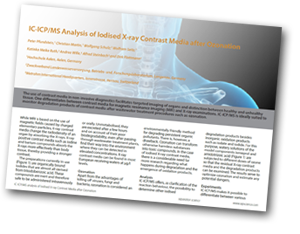The use of contrast media in non-invasive diagnostics facilitates targeted imaging of organs and distinction between healthy and unhealthy tissue. One differentiates between contrast media for magnetic resonance imaging (MRI) and X-ray examinations. IC-ICP/MS is ideally suited to monitor degradation products of contrast media after wastewater treatment procedures such as ozonation.

 Separation Science in collaboration with Metrohm offers an article by Peter Pfundstein et al. While MRI is based on the use of magnetic fields caused by charged elementary particles, X-ray contrast media change the radiodensity of an organ by absorbing the X-rays. X-ray positive contrast media such as iodine and barium compounds absorb the X-rays more effectively than body tissue, thereby providing a stronger contrast.
Separation Science in collaboration with Metrohm offers an article by Peter Pfundstein et al. While MRI is based on the use of magnetic fields caused by charged elementary particles, X-ray contrast media change the radiodensity of an organ by absorbing the X-rays. X-ray positive contrast media such as iodine and barium compounds absorb the X-rays more effectively than body tissue, thereby providing a stronger contrast.
The preparations currently in use are organically bound iodides that are almost all derived from triiodobenzoic acid. These compounds are inert and therefore safe to be administered intravenously or orally. Unmetabolised, they are excreted after a few hours and on account of their poor biodegradability, even after passing through wastewater treatment plants, find their way into the environment where they can be detected in elevated concentrations. X-ray contrast media can be found in most European receiving waters at μg/l levels.
Ozonation
Apart from the advantages of killing off viruses, fungi and bacteria, ozonation is considered an environmentally friendly method for degrading persistent organic pollutants. There is, however, a drawback. Ozonation can transform otherwise harmless substances into toxic compounds. In the case of iodised X-ray contrast media, there is a considerable need for more research regarding what happens during degradation and the emergence of oxidation products.
Analysis
IC-ICP/MS offers, as clarification of the reaction behaviour, the possibility to determine other iodised degradation products besides inorganic oxidation products such as iodate and iodide. For this purpose, watery solutions of the model components iomeprol and amidotrizoic acid are subjected to different doses of ozone so that the residual X-ray contrast media and the degradation products can be examined. The results serve to optimize ozonation and estimate any potential dangers.
To read the full article click the button below...



